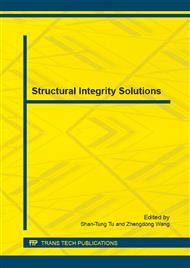[1]
S. Suresh, Fatigue of Materials, second ed., Cambridge University Press, Cambridge, (1998).
Google Scholar
[2]
David Taylor, Geometrical effects in fatigue: a unifying theoretical model, International Journal of Fatigue 21(1999) 413-420.
DOI: 10.1016/s0142-1123(99)00007-9
Google Scholar
[3]
Jaap Schijve, Fatigue damage in aircraft structure, not wanted, but tolerated? , International Journal of Fatigue 31(2009) 998-1011.
DOI: 10.1016/j.ijfatigue.2008.05.016
Google Scholar
[4]
Xiao Jianhua. Rational mechanics V. motion equations, http: /www. paper. edu. cn/releasepaper/ content/ 200702-92. html.
Google Scholar
[5]
Guo Ziqiang, Wave in the Solid (In Chinese), Seismic Press, Beijing, 1982, pp.46-48.
Google Scholar
[6]
Xiao Jianhua, Wang Jingjing, Stress concentration based on non-linear motion equations and its application for non-destructive detective of plate, the 13th International Conference on Fracture, S37-003, Beijing, (2013).
Google Scholar
[7]
Gong Ning, Yang Zhenguo, Failure analysis on composite structure used for automotive accelerator pedals, Physical Testing And Chemical Analysis Part A: Physical Testing, 49 Supplement 2 (2013) 162-165.
Google Scholar
[8]
Zheng Yuan, Cracks analysis of integral blisk blades, Physical Testing and Chemical Analysis Part A: Physical Testing, 49 Supplement 2 (2013) 284-285.
Google Scholar
[9]
K. Slámecka, J. Pokluda, On the topography of fracture surfaces in bending-torsion fatigue, Engineering Fracture Mechanics 75(2008) 760-767.
DOI: 10.1016/j.engfracmech.2007.01.018
Google Scholar
[10]
T. Ghidini, C. Dalle Donne, Fatigue life prediction using fracture mechanics methods, Engineering Fracture Mechanics 76(2009) 134-136.
DOI: 10.1016/j.engfracmech.2008.07.008
Google Scholar
[11]
Franscesso Marino, A. R ebuffo, F. Sorrentino, Effects of Low-cycle fatigue on bending properties and fracture toughness of un-HIP'ed Ti-47Al-2Cr-2Nb-1B intermetallic, International Journal of Fatigue 27(2005) 143-143.
DOI: 10.1016/j.ijfatigue.2004.06.006
Google Scholar
[12]
L.V. Vareda, D. Spinelli, Fatigue, monotonic and fracture toughness properties of a Cr-Mn-N steel, International Journal of Fatigue 23(2001) 857-863.
DOI: 10.1016/s0142-1123(01)00060-3
Google Scholar


